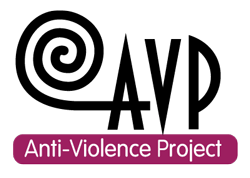Intervening when you see gender-based violence happening
Often we think that the only way to end sexualized violence is by intervening in the moment of assault, but the reality is that while this is important, it is quite unlikely that we will come across these situations. At the Anti-Violence Project, we talk about the need to end rape culture, the culture in which we live that normalizes and glorifies sexualized violence, creating violence and a sense of entitlement to other people’s physical, emotional, and sexual beings without consent. Therefore, preventing gender-based and sexualized violence is also about intervening in the day to day microaggressions we see around us and disrupting the general culture of violence in which we live. Addressing rape culture also includes recognizing that sexualized and gender-based violence cannot be separated from other intersecting forms of violence such as racism, cissexism, colonialism, homoantagonism, ableism, classism, transantagonism, and ageism.
Here are some day to day acts that contribute to rape culture and the normalization of gender-based violence:
- Disrespecting boundaries
- Rape jokes
- Catcalling
- Homoantagonistic slurs
- Slut-shaming
Through daily acts that interruptviolent practices and beliefs, we challenge the ideas that make sexual assault possible. This means confronting your friend when you notice them complaining about their partner’s boundaries related to texting, telling your uncle that that racist joke really wasn’t funny and was actually very harmful, asking your coworker to not make slut-shaming remarks about customers and taking the effort to correct yourself when you see yourself upholding violent ideas. There are so many points of intervention for us to consider when trying to make our communities more consensual and safer for everyone.
Intervening in aggressive situations is also important but can be more difficult especially depending on your identity and ability to keep yourself safe. When safety is not a concern there are still lots of things that prevent bystanders from intervening that are worth thinking about, here are some of those reasons (from http://www.actnowsrilanka.org):
- If no one else is acting, it can be hard to go against the crowd
- People may feel that they are risking embarrassment. What if I’m wrong and they don’t need help?
- They may think there is someone else in the group who is more qualified to help.
- They may think that the situation does not call for help since no one else is doing anything.
- With each person taking cues from people around them, a common result is that no action is taken.
While some models of bystander intervention position bystanders as potential heroes or knights in shining armour, the reality is that rarely do we know exactly the right thing to say or do in a situation. Instead of concentrating on being perfect or “saving” someone, it’s important that you focus on being supportive of someone experiencing violence and whenever possible taking the lead from them. Ask:
- Are you okay?
- Would you like me to call someone for you?
- Can I walk you somewhere away from (the person targeting them)?
Even without engaging with the person who is causing harm it is possible to de-escalate the situation at times simply by engaging the person who is being targeted in conversation. Remember that rarely will you change someone’s behaviour immediately simply by calling it out and naming it as violent, but you do have the opportunity to stop that behaviour in the moment. This can demonstrate to those around you that you refuse to normalize harmful actions.
By broadening our definitions of bystander intervention we can start to see the everyday ways that we are able to take part in the creation of a culture change away from violence and oppression towards respect and care.
If you want some ideas of strategies for practicing bystander intervention, check out these resources:
- Hollaback! is an organization that seeks to end street harassment, that has some suggestions for ways that bystanders can intervene in violent situations involving street harassment. Check out their guide to bystander intervention here: https://www.ihollaback.org/app/uploads/2016/11/Show-Up_CUPxHollaback.pdf
- The University of Victoria offers two programs for students on bystander intervention (online and in-person): https://www.uvic.ca/services/studentlife/initiatives/bystander-intervention/index.php
Resources on calling in/out behaviour:
- “Calling IN: A Less Disposable Way of Holding Each Other Accountable” by Ngọc Loan Trần https://www.bgdblog.org/2013/12/calling-less-disposable-way-holding-accountable/
- “Calling In: A Quick Guide on When and How” by Sian Ferguson https://everydayfeminism.com/2015/01/guide-to-calling-in/
- “No, We Won’t Calm Down – Tone Policing Is Just Another Way to Protect Privilege” by Robot Hugs https://everydayfeminism.com/2015/12/tone-policing-and-privilege/
- “How to Tell Someone They Sound Racist” by Jay Smooth https://www.youtube.com/watch?v=b0Ti-gkJiXc
